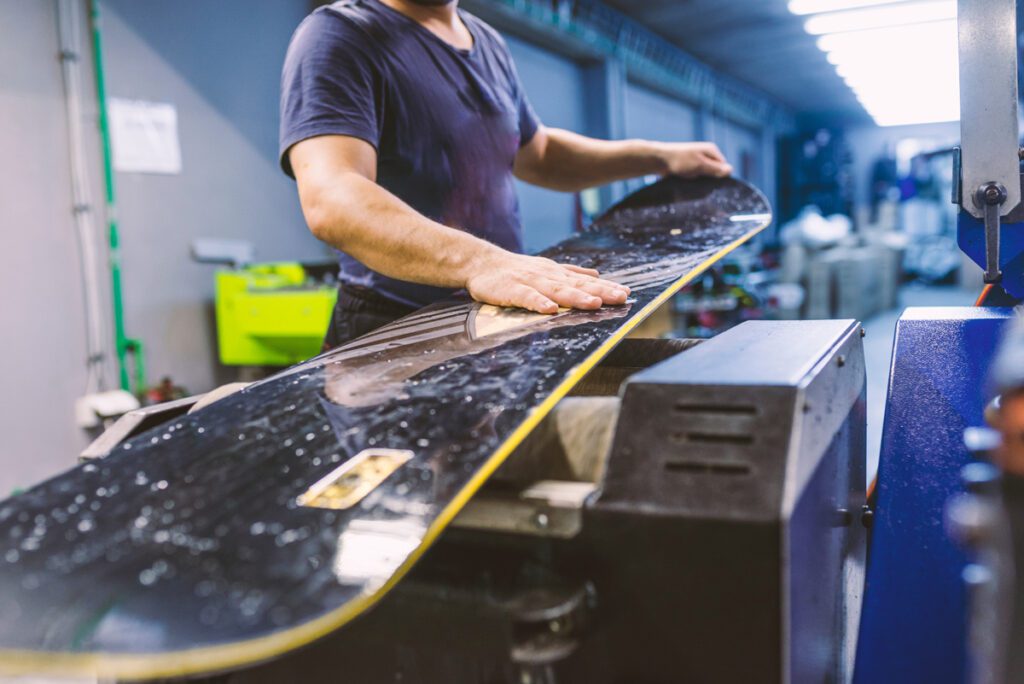How To Prep Your Gear For Summer Storage
Before you pack away your skis and snowboard for the summer, there’s one important step: proper storage. Taking the time to clean, inspect, and prep your gear at the end of the ski season will ensure they’re in top shape come next winter. This guide will walk you through everything you need to do step-by-step.

Cleaning
Hitting the slopes exposes your skis and snowboard to all sorts of elements – snow, dirt, salt, and maybe even a rogue snowball fight. All that fun can leave behind grime that can damage your gear if left unchecked. So, before we move on to anything else, let’s give them a good cleaning!
Here’s what you need:
- A damp cloth or sponge
- A hose (optional)
- Mild soap (optional)
- A clean, dry towel
First things first: Avoid harsh chemicals or abrasive cleaners. They can strip away the protective coating on your skis and snowboard.
Wipe it Down: A damp cloth is usually enough to remove most dirt and debris. If things are extra grimy, a gentle rinse with the hose can help. Just be careful not to use high pressure, which can damage the base.
Focus on the Details: Pay close attention to the topsheet, base, edges, and bindings. Don’t forget those hard-to-reach spots around the bindings when prepping for summer storage! A little soap can help tackle stubborn grime, but rinse thoroughly afterward to remove any residue.
Drying is Key: Once you’re done cleaning, completely dry your skis and snowboard with a clean towel. Leaving them even slightly damp can lead to rust or mold growth during storage. Ideally, let them air dry overnight in a cool, well-ventilated area before proceeding to the next step.

Inspecting and Tuning
Now that your skis and snowboard are clean and dry, it’s time to take a closer look to ensure they’re ready for next season. Here’s where a little inspection and tuning can go a long way during summer storage.
Eagle Eye Inspection: Grab your skis or snowboard and lay them flat on a stable surface. Examine the base and edges for scratches, cracks, or other damage. Even minor nicks can affect performance.
Fixing Minor Damage: Small scratches and gouges can often be repaired with a P-Tex stick. These handy tools use molten plastic to fill in the damage and are surprisingly easy to use. Here’s a step-by-step process of using a P-Tex stick so you can tackle minor repairs yourself.
Leave the Big Stuff to the Pros: It’s best to leave it to the professionals for more extensive repairs or damage to the edges. Ski shops offer expert tuning services that can fix more serious issues and ensure your gear is in peak condition.
Sharpen Up Your Edges: During summer storage, your steel edges can develop some rust. This not only looks bad, but it also affects how well your skis or snowboard grip the snow. Luckily, there are tools available to remove those pesky burrs and prevent rust. If you’re not comfortable sharpening them yourself, don’t worry! You can always get it done professionally when you get your skis tuned up next winter.

Waxing
Now that your skis and snowboard are clean, inspected, and tuned, it’s time to give them a layer of protection for summer storage. Here’s where waxing comes in!
Waxing your base does two important things:
- Protection: It creates a barrier that shields the base from drying out, cracking, or oxidizing during storage.
- Performance: A fresh coat of wax helps your skis or snowboard glide smoothly across the snow next winter.
Waxing Your Skis or Snowboard
There are two main types of waxing methods:
- Hot Waxing: This traditional method uses a hot iron to melt wax onto the base. It offers a deeper wax penetration and longer-lasting protection, but requires specific tools and a bit more effort.
- Cool Iron Waxing: This more straightforward option uses a pre-waxed block or iron-on film. It’s great for beginners or those short on time, but it might not offer the same level of protection as hot waxing.
Choosing the Right Wax: Don’t just grab any old wax! For summer storage, you’ll want to use an all-temperature or warm-weather wax. These are formulated to be applied at lower temperatures and offer the ideal protection for warmer summer months.
Lay It On Thick: Here’s the key difference for summer storage: unlike a regular ski prep, you won’t scrape off the wax after applying it. Leave that layer on! It will act as a shield for your skis or snowboard throughout the summer.
Bonus Tip: Want extra protection for your edges? You can apply a thin coat of wax to them as well. This helps prevent rust and keeps them nice and sharp for next season.

Storage
We’ve cleaned, inspected, tuned, and waxed your skis and snowboard – they’re looking great! But before you toss them in the back corner of the garage and forget about them, there’s one more step: proper storage during the summer. Here’s how to ensure your gear stays in top shape all summer.
Loosen Up the Bindings: Metal components in bindings can get stressed if they’re left compressed for long periods. To prevent any damage, take a moment to loosen the tension on your bindings.
How to Loosen: Most bindings have a DIN setting that adjusts the release force. To relieve the pressure on the springs, simply lower the DIN setting to a low number (around 2 or 3). Refer to your binding’s manual for specific instructions.
Finding the Perfect Spot: Now it’s time to choose a storage location. The ideal spot is cool, dry, and out of direct sunlight. Avoid storing your skis and snowboard in extreme temperatures, like a hot attic or a damp basement.
How to Store Ski Gear for Summer
How you store your skis and snowboard matters. Here are two options for summer storage:
- Flat on the Base and Topsheet: This option is good if you have the space. Lay them flat on a stable surface, like a shelf or a rack.
- On Edges: If space is tight, you can store them on their edges. Just be sure to alternate the edges they’re resting on every few months to prevent warping.
Avoid the Tip and Tail: Never store your skis or snowboard on their tip or tail. This can put unnecessary stress on those areas and lead to damage.
Extra Protection: For added protection from dust, scratches, or minor bumps, consider storing your skis and snowboard in a ski bag.
Bonus Tip: Got boots? Don’t forget about them! Clean and dry your boots thoroughly, remove the liners and store them separately in a cool, dry place. Remember, a little care now will go a long way in keeping your entire ski and snowboard setup ready for next season.